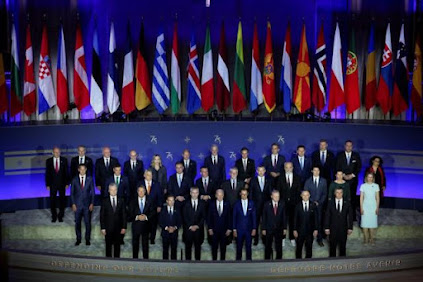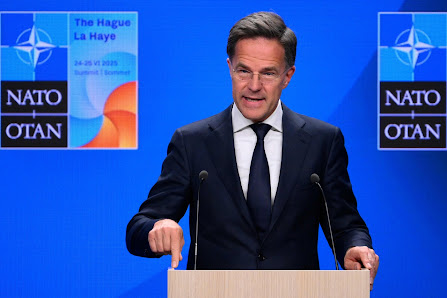NATO Summit 2025 commenced in The Hague this week with rising tensions over defense spending commitments and the ongoing war in Ukraine. As world leaders, including US President Donald Trump, gather for the two-day NATO Summit 2025, the outcome could either solidify the alliance’s stance or deepen internal divisions.
🇺🇸 Trump’s Push and Defense Spending Dispute
At the center of NATO Summit 2025 is the controversial 5% GDP defense spending proposal. NATO Secretary-General Mark Rutte had initially expressed hope that all European members and Canada might match U.S. spending levels. However, Spain rejected the goal as “unreasonable.” Trump, a firm advocate for the 5% target, criticized Spain and Canada for underperforming, labeling them “low payers.”
At the NATO Summit 2025, leaders must find common ground on spending. NATO functions through consensus, and Spain’s opposition threatens any formal adoption of new targets. According to NATO data, Spain and Canada remain among the lowest defense contributors—spending under 2% and 1.45% of GDP respectively. This has reignited debate on fair burden-sharing.
The controversy escalated when Trump ordered strikes on Iran’s nuclear facilities, reviving memories of NATO’s 2003 Iraq division. Some fear that the NATO Summit 2025 might echo past splits, especially as Europe pushes to keep Ukraine high on the agenda. Allies want to ensure continued support for Kyiv while worrying that Trump may sideline President Zelenskyy.
Although Zelenskyy has been invited, it’s unclear whether he will participate in core summit talks. His presence, even during Tuesday’s informal dinner, could shape diplomatic dynamics at the NATO Summit 2025. Meanwhile, a short, vague joint statement is being prepared to avoid disagreements over wording—a symbolic indicator of underlying tensions.
Since its founding in 1949, NATO’s primary mission has been defending Europe against external threats, originally from the Soviet Union. Today, with 32 member states including newcomers Finland and Sweden, its focus includes deterring Russian aggression in the post-Cold War era. The NATO Summit 2025 highlights the alliance’s continued adaptation to changing global threats.

Despite internal rifts, NATO’s Article 5 remains its cornerstone: an attack on one member is considered an attack on all. Trump has offered mixed signals, affirming the U.S. commitment to the alliance while questioning the value of respecting defense pledges others fail to meet.
As the strongest military power in NATO, the U.S. provides nuclear deterrence and contributes significantly more in defense resources than other members. While Washington traditionally leads the NATO agenda, Trump’s leadership style has introduced unpredictability at the NATO Summit 2025. His criticism of allies and tariff threats have weakened deterrence efforts, say defense analysts.
Notably, NATO itself does not provide lethal aid to Ukraine. As an organization, its support has been limited to non-lethal equipment—combat rations, fuel, protective gear, and counter-drone systems. However, individual NATO nations have filled the gap: European allies alone accounted for 60% of Ukraine’s military aid in 2024. NATO coordinates arms deliveries through a logistics hub on the Polish border and facilitates training.
The NATO Summit 2025 also revisits alliance readiness. Under its new plan, 300,000 troops should be ready for rapid deployment within 30 days in the event of an attack—on land, sea, air, or cyberspace. But experts question whether the members can muster such a force on time, considering both manpower and logistical constraints.
After Russia’s annexation of Crimea in 2014 and full-scale invasion of Ukraine in 2022, NATO members pledged to meet a minimum 2% GDP defense spending threshold. Progress is visible—22 countries hit the target last year compared to just three a decade ago. The NATO Summit 2025 was expected to raise this to 3.5%, with an additional 1.5% for infrastructure resilience like roads, ports, and airfields.
Still, Spain’s rejection and Trump’s fluctuating position make this uncertain. As the NATO Summit 2025 progresses, whether consensus can be achieved on these ambitious defense goals remains an open question.
Summary Highlights:
- Focus Keyword: NATO Summit 2025
- Venue: The Hague, Netherlands
- Key Issues: Defense spending, Ukraine war, Iran strikes, Article 5 credibility
- Defense Spending Proposal: 5% of GDP (opposed by Spain)
- Zelenskyy’s Role: Invited, but sidelined in formal talks
- NATO’s Lethal Aid: Provided individually, not as an organization
- US Role: Largest spender, but leadership questioned under Trump
- Rapid Response Plan: 300,000 troops in 30 days (feasibility in doubt)
- Spending Targets: From 2% to proposed 3.5% + 1.5% infrastructure
Spain Rejects NATO Defense Spending Hike Amid Global Security Tensions

